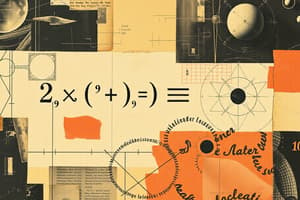Podcast
Questions and Answers
Who proposed the Schrödinger's cat thought experiment?
Who proposed the Schrödinger's cat thought experiment?
- Niels Bohr
- Albert Einstein
- Erwin Schrödinger (correct)
- Max Planck
What is the purpose of Schrödinger's cat thought experiment?
What is the purpose of Schrödinger's cat thought experiment?
- To prove the existence of superposition in quantum mechanics (correct)
- To demonstrate the theory of general relativity
- To explain wave-particle duality
- To study the photoelectric effect
Which physicist laid the foundation for quantum theory with the discovery of the photoelectric effect?
Which physicist laid the foundation for quantum theory with the discovery of the photoelectric effect?
- Niels Bohr
- Albert Einstein
- Erwin Schrödinger
- Max Planck (correct)
Who developed the concept of wave-particle duality, further solidifying the idea that particles could exhibit both wave-like and particle-like behavior?
Who developed the concept of wave-particle duality, further solidifying the idea that particles could exhibit both wave-like and particle-like behavior?
What is the primary purpose of Schrödinger's cat thought experiment?
What is the primary purpose of Schrödinger's cat thought experiment?
Where was Schrödinger's cat thought experiment first published?
Where was Schrödinger's cat thought experiment first published?
What impact has Schrödinger's cat thought experiment had on quantum mechanics?
What impact has Schrödinger's cat thought experiment had on quantum mechanics?
What principles of quantum mechanics are essential in the development of quantum computing?
What principles of quantum mechanics are essential in the development of quantum computing?
What is the nature of particles in quantum mechanics until they are observed or measured?
What is the nature of particles in quantum mechanics until they are observed or measured?
Where was the paper, 'Die Gegenwärtige Situation in der Quantenmechanik', later translated and published?
Where was the paper, 'Die Gegenwärtige Situation in der Quantenmechanik', later translated and published?
Flashcards are hidden until you start studying
Study Notes
S.S.T: A Historical Overview
S.S.T, or Schrödinger's cat thought experiment, is a fundamental concept in quantum mechanics that has captured the interest of physicists, philosophers, and the general public alike. This thought experiment, proposed by the Austrian physicist Erwin Schrödinger in 1935, is designed to illustrate the principles of quantum mechanics and the concept of superposition. In this article, we will explore the history of S.S.T, its principles, and its implications for the field of quantum mechanics.
Early Developments in Quantum Mechanics
Before delving into the specifics of Schrödinger's cat thought experiment, it is essential to understand the historical context in which it was developed. The early 20th century saw the rapid development of quantum mechanics, a revolutionary new theory that fundamentally changed our understanding of the physical world. Key figures in this development include Max Planck, Albert Einstein, Niels Bohr, and Schrödinger himself. Planck's discovery of the photoelectric effect in 1900 laid the foundation for quantum theory, while Einstein's theory of the photoelectric effect and his development of the concept of wave-particle duality further solidified the idea that particles could exhibit both wave-like and particle-like behavior.
Schrödinger's Cat Thought Experiment
The idea behind Schrödinger's cat thought experiment is to illustrate the concept of superposition in quantum mechanics. In this thought experiment, a cat is placed inside a sealed box with a radioactive atom, a Geiger counter, and a vial of poison. If the Geiger counter detects radiation, the vial of poison is broken, and the cat dies. However, until the box is opened, the cat is in a superposition of both alive and dead states. This paradox demonstrates the strange and counter-intuitive nature of quantum mechanics, where particles can exist in multiple states simultaneously until they are observed or measured.
The Publication of Schrödinger's Cat
Schrödinger's cat thought experiment was published in a paper titled "Die Gegenwärtige Situation in der Quantenmechanik" (The Present Situation in Quantum Mechanics), which was delivered as a lecture at the Solvay Conference in Brussels in 1935. The paper was later translated and published in Nature. The thought experiment quickly gained notoriety and became one of the most famous thought experiments in the history of physics.
The Legacy of Schrödinger's Cat
Schrödinger's cat thought experiment has had a significant impact on the field of quantum mechanics and continues to influence research and discussions in the field today. It has been used to explore various aspects of quantum mechanics, including the nature of quantum states and the measurement problem. The experiment has also played a crucial role in the development of quantum information theory and quantum computing, which rely on the principles of superposition and entanglement.
In summary, S.S.T, or Schrödinger's cat thought experiment, is a fundamental concept in quantum mechanics that has shaped the way we understand the physical world. Developed by Erwin Schrödinger in the early 20th century, the experiment has had a lasting impact on the field of quantum mechanics and continues to inspire research and discussions to this day.
Studying That Suits You
Use AI to generate personalized quizzes and flashcards to suit your learning preferences.




